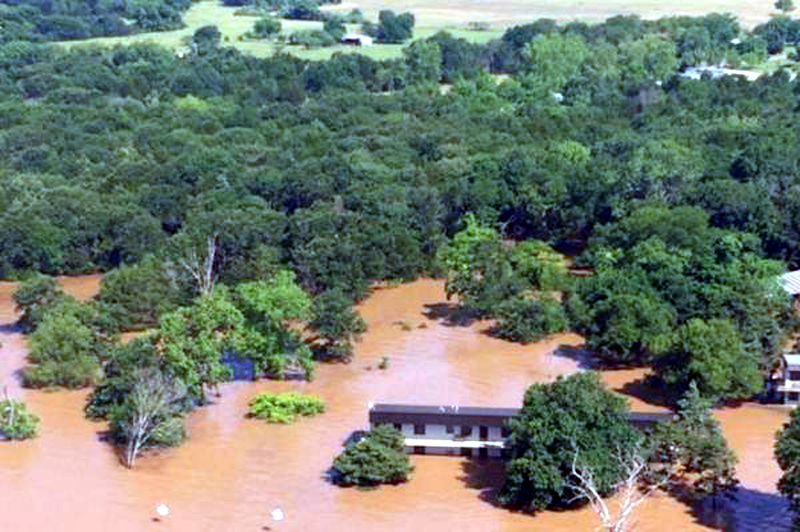"I will never forget picking up the traps, and it just seemed like every trap had one cricket and one spider," said researcher Karl A. Roeder
 |
| In the wake of a massive flood in Oklahoma, scientists measure significant decreases in the abundance and diversity of insects and invertebrates. Photo by Jeff Thrasher |
By Brooks Hays, UPI
Much attention is paid to the impact of natural disasters on land and humans. Some attention is paid to larger animals. But what about the smallest creatures, insects and other invertebrates?
New research suggests natural disasters can have a significant impact on the abundance and diversity of small species.
[post_ads]When researchers surveyed insects and invertebrate populations nine months after a 100-year flood struck south central Oklahoma in 2015, they measured a 93 percent decrease in abundance. Researchers also measured significant decreases in species presence, biomass and diversity.
"I will never forget picking up the traps, and it just seemed like every trap had one cricket and one spider," lead researcher Karl A. Roeder, a doctoral student at the University of Oklahoma, said in a news release. "The area had transitioned from a diverse insect community to a large expanse of crickets and spiders. We were pretty surprised at how similar everything was."
Roeder and his colleagues are keen to understand how invertebrate communities rebound in the wake of disasters like historic floods. Like most food chains and ecosystems, the multitude of smaller species play a variety of vital roles -- whether food for small predators or ecosystem engineers.
If some insects and invertebrates are unable to recolonize in the wake of a disaster, an ecosystem could be permanently altered.
"If such species are unable to perform functions of the displaced individuals -- such as soil cycling, decomposition, or pollination -- ecosystems may have trouble returning to their previous states," Roeder said.
[post_ads_2]
Researchers at Oklahoma originally set out to measure the impact of a controlled burn on local insect and invertebrate communities near the Oklahoma-Texas border. Scientists conducted their baseline survey, but before the burn could happen, the rain arrived and didn't let up. As a result, the research team was presented with a new opportunity.
The results of that new research opportunity were published this week in the journal Environmental Entomology.
Nine months after the flood, scientists returned to survey the same land -- land that had spent several months underwater. They found only 3 of 14 ant species were present and that isopods and millipedes had failed to return.
"We noticed a large amount of dead vegetation at our site. Yet detritivores like millipedes and isopods that normally break down decomposing vegetation were largely gone," Roeder said. "Instead, we recorded an increase in large-bodied groups like field crickets, spiders, and beetles. This change may have important consequences for the survival of amphibians, mammals, and reptiles, which opportunistically prey upon these larger invertebrate groups, or for birds as they fuel up for migration."
Researchers hope followup studies will shed more light on how insect and invertebrate communities evolve as vegetation regenerates and lands recover from the impact of a natural disaster.
Much attention is paid to the impact of natural disasters on land and humans. Some attention is paid to larger animals. But what about the smallest creatures, insects and other invertebrates?
New research suggests natural disasters can have a significant impact on the abundance and diversity of small species.
[post_ads]When researchers surveyed insects and invertebrate populations nine months after a 100-year flood struck south central Oklahoma in 2015, they measured a 93 percent decrease in abundance. Researchers also measured significant decreases in species presence, biomass and diversity.
"I will never forget picking up the traps, and it just seemed like every trap had one cricket and one spider," lead researcher Karl A. Roeder, a doctoral student at the University of Oklahoma, said in a news release. "The area had transitioned from a diverse insect community to a large expanse of crickets and spiders. We were pretty surprised at how similar everything was."
Roeder and his colleagues are keen to understand how invertebrate communities rebound in the wake of disasters like historic floods. Like most food chains and ecosystems, the multitude of smaller species play a variety of vital roles -- whether food for small predators or ecosystem engineers.
If some insects and invertebrates are unable to recolonize in the wake of a disaster, an ecosystem could be permanently altered.
"If such species are unable to perform functions of the displaced individuals -- such as soil cycling, decomposition, or pollination -- ecosystems may have trouble returning to their previous states," Roeder said.
[post_ads_2]
Researchers at Oklahoma originally set out to measure the impact of a controlled burn on local insect and invertebrate communities near the Oklahoma-Texas border. Scientists conducted their baseline survey, but before the burn could happen, the rain arrived and didn't let up. As a result, the research team was presented with a new opportunity.
The results of that new research opportunity were published this week in the journal Environmental Entomology.
Nine months after the flood, scientists returned to survey the same land -- land that had spent several months underwater. They found only 3 of 14 ant species were present and that isopods and millipedes had failed to return.
"We noticed a large amount of dead vegetation at our site. Yet detritivores like millipedes and isopods that normally break down decomposing vegetation were largely gone," Roeder said. "Instead, we recorded an increase in large-bodied groups like field crickets, spiders, and beetles. This change may have important consequences for the survival of amphibians, mammals, and reptiles, which opportunistically prey upon these larger invertebrate groups, or for birds as they fuel up for migration."
Researchers hope followup studies will shed more light on how insect and invertebrate communities evolve as vegetation regenerates and lands recover from the impact of a natural disaster.















COMMENTS